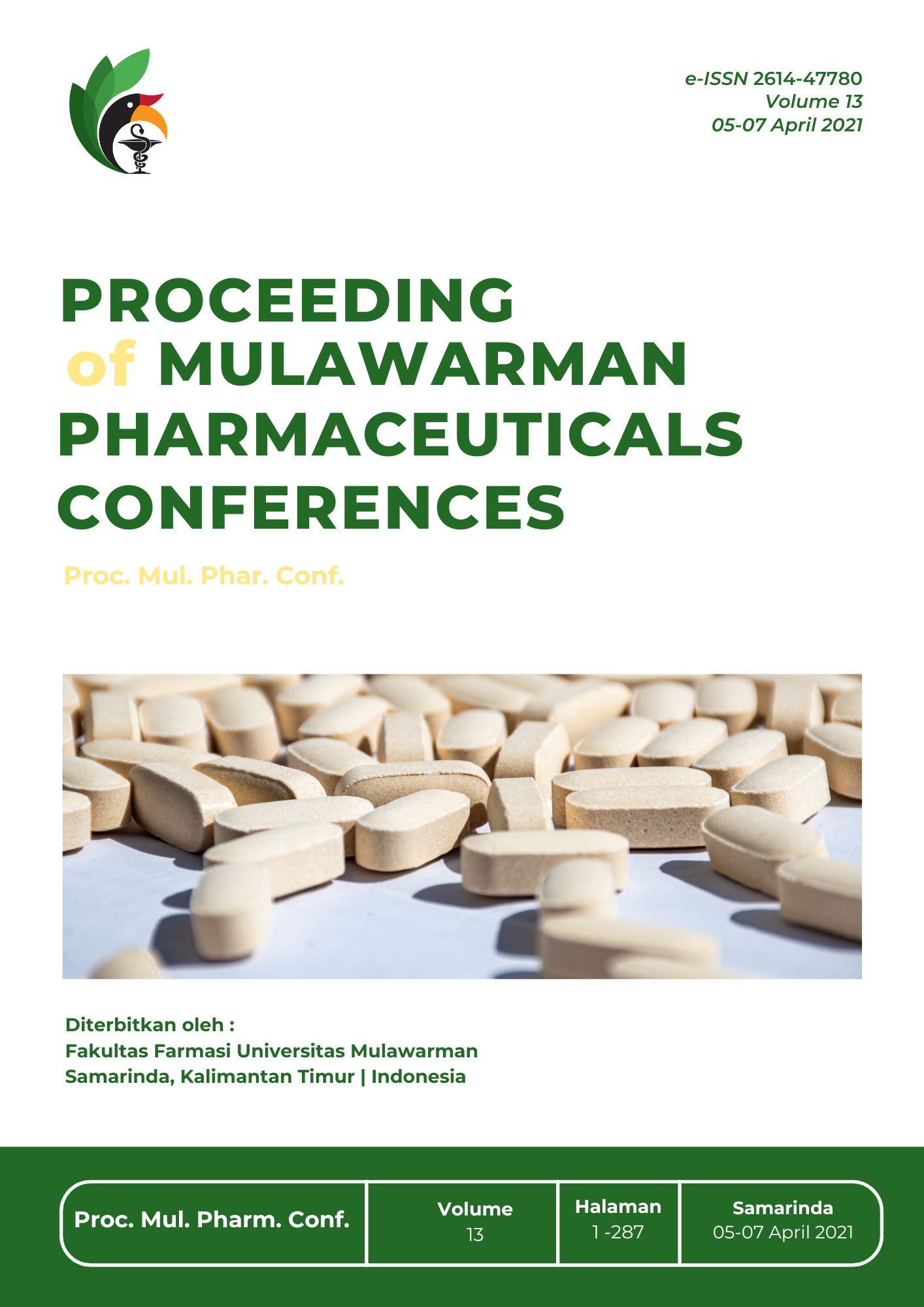Potential of n-Hexane and Ethanol Extract from Betel Leaves (Piper betle Linn) as a Mouth Remover Caused by Bacteria Staphylococcus aureus
DOI:
https://doi.org/10.30872/mpc.v13i.388Keywords:
betel leaf, piper betle linn, Staphylococcus aureus, inhibitionAbstract
The mouth is an ideal place for the growth and development of microorganisms because the mouth has moisture and a regular intake of food. Microbes found in the mouth, namely Staphylococcus aureus which can cause bad breath, one type of plant that is used as a bad breath remover is betel leaf. Betel leaf (Piper betle Linn) contains chavikol and betlephenol which can inhibit bacterial growth. This study aims to identify the class of compounds in betel leaf that have potential as antibacterial properties against S. aureus bacteria. The betel leaf was dried, then crushed to expand the surface of the sample (simplicia). Simplicia as much as 300 grams of macerated stratified with n-hexane, ethyl acetate and ethanol. The result was evaporated and the weight of each extract was 6.4371 g (n-hexane), 8.8007 g (etylacetate) and 9.2173 g (ethanol). Phytochemical tests and thin layer chromatography (TLC) using eluent n-hexane and ethyl acetate (8: 2) showed that n-hexane extract was thought to contain flavonoids, ethyl acetate extract containing saponins and ethanol extract containing polyphenols. Antibacterial activity test was carried out by using the paper disc diffusion method. Both the n-hexane extract and the ethanol extract of betel leaf showed very strong antibacterial activity, characterized by a diameter of inhibition above 20 mm.
References
[1] Jawetz. 1982. Mikrobiologi Untuk Profesi Kesehatan. keempat belas ed. Jakarta: Buku Kedokteran.
[2] Syukur C, 1999. Hernani. Budidaya Tanaman Obat Tradisional. Jakarta: PT. Penebar Swadaya.
[3] Agustin DW. 2005. Perbedaan Khasiat Antibakteri Bahan Irigasi Antara Hidrogen Peroksida 3% dan infusum Daun Sirih 20% Terhadap Bakteri Mix, Maj. Kedokteran Gigi. ISSN 2442-9740.
[4] Hermawan A. 2007. Pengaruh Ekstrak Daun Sirih (Piper Betle L.) Terhadap Pertumbuhan Staphylococcus aureus Dengan Metode Difusi Disk. Skripsi Thesis Universitas Airlangga, Surabaya.
[5] POM D. 1979.Farmakope Indonesia. 3rd ed. Jakarta.
[6] Febriani NW. 2014. Aktivitas Antibakteri Ekstrak Etanol dan Fraksi -Fraksi dari Daun Kelapa Sawit Terhadap Staphylococcus aureus dan Bacillus subtilis serta Profil Kromatografi Lapis Tipisnya. Surakarta: UMS.
[7] Indrayani L, Soetjipto H, Sihasale L. 2006.S krining Fitokimia dan Uji Toksisitas Ekstrak Daun Pacut Kuda (Stachytapheta jamaicensis L. Vahl) Terhadap Larva Udang Artamia Salina Leach. Berk. Panel. Hayati : 12 (57- 61).
[8] Septiana L. 2012. Aktivitas Sitotoksik Fraksi Semi Polar Ekstrak Etanol Kulit Batang Sirsak (Annona muricata Linn.) Terhadap Sel T47D. Surakarta: Universitas Muhammadiyah Surakarta.
[9] Utami NP., 2013.Skrining Fitokimia dan Uji Aktivitas Antibakteri dari Ekstrak Metanol dan Fraksi Kloroform Daun Sirsak. Medan: Universitas Sumatera Utara.
[10] Stephen J., 2005, Manual of Antimicrobial Susceptibility Testing. America: America Society for Microbiology.
[11] Harborne JB., 1987, Metode Fitokimia, Penuntun Cara Modern Menganalisa Tumbuhan, Penerjemah; K.Padmawinata. 2nd ed. Bandung: ITB.
[12] Muhlisah F., 2005, Tanaman Obat Keluarga. Jakarta: Penebar Swadaya.
[13] Pelczar MJ, Chan ECS, Crieg NR., 1986, Dasar-Dasar Mikrobiologi. Penerjemah: Hadieoetomo,R.S. Imas,T., Tjitrosomoso, S., dan Lestari, S. Cetakan pertama. Jilid Satu. Jakarta: UI Press.
[14] Robinson T., 1995, Kandungan Organik Tumbuhan Tinggi. Edisi ke-4 Terjemahan Kosasih Padmawinata. Bandung : ITB Press.
[15] Moeljanto D., 2003, Khasiat dan Manfaat Daun Sirih Obat Mujarab dari Masa ke Masa. Jakarta: Agromedia Pustaka.
[16] Morales G, Sierra P, Mancilla, Parades A, Loyola LA, Gallardo O, Borquez J. 2003. Secondary Metabolites from Four Medicinal Plants from Northern Chile, Antimicrobial Activity, and Biotoxicity against Artemia salina. Journal Chile Chem. 48 (2).
Downloads
Published
Issue
Section
License
Copyright (c) 2021 Nunung Kurniasih, Assyifa Junitasari, Lilis Nurjanah, Anggita Rahmi Hafsari (Author)

This work is licensed under a Creative Commons Attribution-NonCommercial 4.0 International License.


